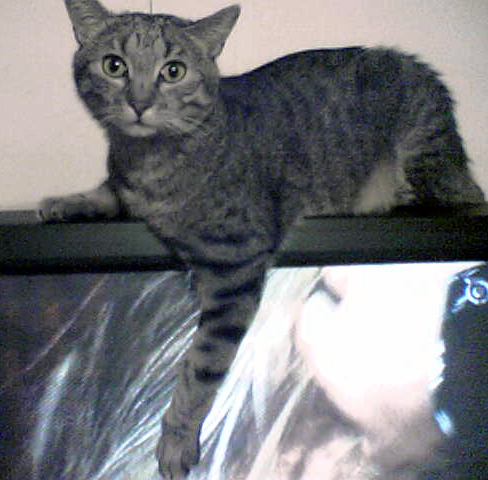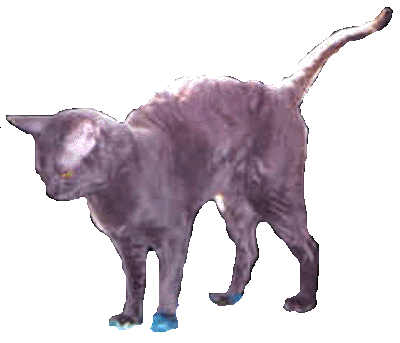|
jokikatin |
||||||
|
Kiharoita ja täpliä/Spots and Curls |
||||||
|
German rex |
||||||
|
|
|
|
Näyttelytuloksia |
|
|
|
| Show results | ||||||
| Uutisia/News | ||||||
|
NEW!! NEW!! Read: * A critical view of the German Rex breed's ancestry
|
||||||
|
KIHARAKARVAISISTA RODUISTA VANHIN
Jokikatin Scherzo näyttelyssä Dresdenissä 8.10.2005 on show in Dresden, Germany |
THE OLDEST OF THE CURLY-COATED BREEDS
Frohlocket alias Lokki Preiset die Tage alias Pressa muuttivat Saksaan 8.10.2005 moved to Germany on 8 October 2005
|
|||||
|
KIHARAKARVAISISTA RODUISTA VANHIN * German rexin synnystä lue sivuilta German rex historia, klikkaa *Kaikki maailman german rexit, lista 2005, klikkaa * Kriittistä pohdiskelua german rex -rodusta, klikkaa * German rexin löytäjän Tri Rose Scheuer-Karpinin tarina, klikkaa
JOKIKATIN GERMAN REXIT
Jokikatin Finale, GRX hybr. "Missä on isoveljeni Molle?" "Where is my big brother Molle?" Foto: Mervi Kurki Jokikatin väki kiittää erityisesti kolmea henkilöä, joiden ansiosta german rex -rotu on yhä olemassa ja saatu jopa Suomeen: ö Ilona Jänicke Saksasta Hankki ensimmäiset germaninsa Schwarzenbachilta ja on sen jälkeen ryhtynyt tarmokkaasti luomaan omaa linjaansa käyttäen rohkeasti noita tarpeellisia hybridejä (rexin ja suorakarvaisen risteymiä) geenipohjan laajentamiseen. Ilona Jänicke haravoi yhdessa Andrea Edelin kanssa läpi koko Saksan ja löysi yllätyksekseen muutaman kasvattajan ja joitain leikkaamattomia german rexejä, mm. naamioväritteisiä. Ilona Jänicken ansiosta german-harrastajien määrä on alkanut kasvaa Keski-Euroopassa, ja Ilona on rodun keskushenkilö. Jänickeltä on meille muuttaneet ensimmäinen naaraamme Saxonys-Charlotta vom Batu ja kolli Batu's Germanus-Rex.
ö Uschi Schwarzenbach Sveitsistä Kun Saksassa alkoi kiinnostus omaa kansallisrotua kohtaan hiipua 1980- ja 1990-luvuilla, sveitsiläinen Uschi Schwarzenbach jäi lähes ainoaksi germanien geenipankin vaalijaksi. Hänellä oli käytössään vanhoja linjoja, mutta hän ymmärsi heti, että kasvatusta ei voi jatkaa yksinomaan näiden varassa, vaan oli harkitusti laajennettava geenipohjaa käyttämällä avuksi alkuaikojen german rexien luonnollista valintaa, kotikissaa. Nykyisen saksalaisenkin kasvatuksen pohjana on juuri Uschi Schwarzenbachin german rex -kanta. Uschin kirjoittama artikkeli german rexistä, joka oli julkaistu saksalaisen FIFé-yhdistyksen, meidän Kissaliittoamme vastaavan järjestön, lehdessä, sai meidätkin kiinnostumaan tästä rodusta.
ö Petra Hein Saksasta On toinen vahvoista saksalaisista german rexin elvyttäjistä ja tekee edelleen tiivistä yhteistyötä Uschi Schwarzenbachin kanssa. Häneltä on meille muuttanut ensimmäinen hybridikollimme Herkules ja kiharaturkkinen naaras Julietta von den Katzentreppen.
Miten german rex saapui Suomeen Suomeen ensimmäiset german rexit tulivat Jokikatin kissalaan Somerolle 4.7.2001 Ilona Jänicken kasvattama musta naaras Saxonys-Charlotta vom Batu (Lotti) ja punainen tabby hybridipoika Herkules von den Katzentreppen (Herkku) Petra Heinilta. Julietta von den Katzentreppen muutti kissalaamme helmikuussa 2002 niin ikään Heinien perheestä ja helmikuussa 2003 saapui jälleen Ilona Jänickeltä Batus Germanus-Rex, sinitabbynaamio poika. Ensimmäiset Suomessa syntyneet pennut Lotti ja Herkku saivat pentuja kesäkuun lopulla 2002: kaksi kiharakarvaista, joista toinen on sininen ja toinen sinitäplikäs sekä kaksi suorakarvaista ns. hybridipentua, molemmat täplikkäitä
Jokikatin Alegro molto ja/and Andante s./b.28.6.2002 Kun pennut alkoivat syntyä, radiossa soi Mozartin 40.sinfonia. Se osien mukaan pennut saivat nimensä: Allegro molto (Molle), Andante (Antti), Menuetto (Mikko Vilkastus 1) ja Finale (Mikko Vilkastus 2).
Jokikatin germanit nyt Jokikatin kissalassa on tällä hetkellä german rexejä (toukokuu 2005) naaraita: Saxonys-Charlotta vom Batu, musta GRX Julietta von den Katzentreppen, sinitabby GRX Jokikatin Fantaisie, ruskeakilpikonna tabby GRX-hybridi, s.2003 Jokikatin Maria Barbara, kihara, musta-valkoinen bikolori, CRX + GRX -hybridi, s. 5.4.2005
uroksia: Jokikatin Scherzo, sinitabby GRX Jokikatin Fuga, sinitabby tonkineesinaamio GRX, s. 26.6.2004 Herkules von den Katzentreppen, punainen tickedtabby GRX-hybridi ja Jokikatin Allegro molto, sinitabby GRX, jonka lainasimme yhtä astutusta varten Saksaan. Siitä on nyt (2005 syksyllä) kulunut kaksi ja puoli vuotta, emmekä ole onnistuneet saamaan poikaa takaisin. Sillä on teetetty useita pentueita, joista pentuja on muuttanut mm. Hollantiin ja Tanskaan. Uusia omistajia ei häiritse lainkaan, että astutus on teetetty varastetulla kollilla. Ainakin kaksi on rekisteröity FIFé:n alaiseen järjestöön, eikä näitäkään ole kiinnostanut, miten pennut ovat alkunsa saaneet.
Millainen on german rex? German rexin tunnusomaisin piirre on plyysiäkin pehmeämpi paksu, laineikas tai kihara turkki. German rexillä turkin kihartuvuuden saa aikaan sama geeni kuin
cornish rexillä, vaikka näiden rotujen synnyllä ei tiettävästi
ole mitään yhteyttä toisiinsa. German rex on keskikokoinen kissa, jolla on keskipitkä, vankka ja lihaksikas vartalo. Selkä on suora hartioista hännän tyveen. Häntä on keskipitkä ja pyöreäkärkinen. Pää on pyöreähkö, korvien väli leveä, posket voimakkaasti kehittyneet, ja nenänvarressa on loiva syvennys. Korvat ovat tyvestään leveät ja pyöreäkärkiset ja myös sisäpuolelta hienon karvan peitossa. Silmät ovat etäällä toisistaan. Turkki tekee german rexistä rexin. Se on plyysinpehmeä, kihara tai laineikas ja se saa olla minkä värinen tai kuvioinen tahansa. German rex on seuranhaluinen, rakastava ja reipas kissa.
Jokikatin Preiset die Tage german rex, s/b. 31.10.2004
|
THE OLDEST OF THE CURLY-COATED BREEDS To read more, please click NEW!! NEW!! * A critical view of the German Rex breed's ancestry * For more information on German Rex history pages. * List of all German Rexes in the world
Batu's Germanus-Rex Foto Anne Jessen
As this is written (2005), there are some 40 - 50 German
Rexes in the entire world. However, work to revive the breed has started in
Germany, Switzerland and in Finland. The 1st photographed German Rex, Munk, was born in the late 1920's in Königsberg, East Prussia (the present Kaliningrad area). Some cats were taken to Berlin in the 1940's. The breed caught the fancy of those who saw it, but there was little breeding, as most cats remained behind the Iron Curtain. When Germany was unified in the late 1980's, it was possible to gather together what was left of the breed, including the cats that were living in Switzerland. At this stage two ladies worked actively for the breed: Ilona Jänicke and Andrea Edel. They searched throughout Germany and found remaining fertile German rexes, among them some pointed. How German Rex arrived in Finland We at Jokikatin would like to thank three persons in particular, thanks to whom the German Rex breed still exists, and can now be found even in Finland: öIlona Jänicke from Germany She received her first German Rexes from Ushci Schwarzenbach, and since built up her own line, using the ubiqutious hybrids (crosses between a Rex and a cat with a straight coat) with the goal of enlarging the gene pool. Ilona Jänicke and Andrea Edel checkd through Germany and foun much to their surprise some breeders and fertile cats, among them some pointed. Thanks to Ilona Jänicke the number of German Rex fanciers is increasing in Central Europe. From Jänicke we have received our first female Saxonys-Charlotta vom Batu and a male Batu's Germanus-Rex.
ö Uschi Schwarzenbach from Switzerland As the interest for the German national breed started diminishing in the 1980’s and 1990’s, Uschi Schwarzenbach from Switzerland became practically the only breeder maintaing the German Rex gene bank. She had old lines, but she realized soon that breeding cannot be continued just using the existing cats. The gene pool would have to be widened using the natural choice of the early German Rexes, the housecat. The present breeding work is based on the German Rexes from Uschi Schwarzenbach. Published in the German magazine "die Edelkatze", an article written by Uschi made even us interested in the breed.
öPetra Hein from Germany The other German reviver of the German Rex, still working in close cooperation with Uschi Schwarzenbach. We have received from her our first hybrid male Herkules and a curly coated female Julietta von den Katzentreppen.
The first German Rexes to arrive in Finland on 4 July 2001 are the black female Saxonys-Charlotta vom Batu and the red ticked tabby hybrid male Herkules von den Katzentreppen. They settled down in Somero. Julietta von den Katzentreppen (Jetti) arrived in February 2002 and Batu's Germanus-Rex in February 2003. The first GRX litter was born in June 2002.
German rexes at Jokikatin (May 2005)
I'm Jokikatin Allegro molto, blue GRX. I wish I were at my real home in Finland. But an greedy ... holds me in captivity.
Females Saxonys-Charlotta vom Batu, black GRX Julietta von den Katzentreppen, blue tabby GRX Jokikatin Fantaisie, brown tortie tabby GRX hybrid, b.2003 Jokikatin Maria Barbara, curly, black white bicolor, CRX + GRX -hybrid, b. 5.4.2005 Jokikatin Anna Magdalena, curly black CRX + GRX -hybrid, b. 5.4.2005
Males Batus Germanus-Rex, blue point tabby GRX Jokikatin Scherzo, blue tabby GRX Jokikatin Fuga, blue tabby tonkinese point GRX, b. 26.6.2004 Herkules von den Katzentreppen, red ticked tabby GRX hybrid Jokikatin Allegro molto, blue tabby GRX, which we loaned for one mating to Germany. That was two and half years ago (Autumn 2005) and he is still in Germany. He has sired several litters, of which kittens have been sold at least to The Netherlans and Denmark. The new owners ignore the fact that we own the sire. At least two of the kittens have been registered in FIFé clubs, neither of which were interested in the fact that the male has been used without the owner's permission.
Jokikatin Johann Ambrosius, black white van, CRX + GRX -hybrid, b. 5.4.2005 Jokikatin Johann Sebastian, blue, CRX + GRX -hybrid, b. 5.4.2005
Description of German rex
Jokikatin Scherzo (Magazine Kissafani 6/2004) Foto Sauli Kaipainen The German rex is medium in size and length, strong and muscular but not massive or fat. In profile the chest is rounded and strong. Legs fine and of medium length; feet small and rounded. The tail is medium in length; from a substantial base it tapers to a rounded tip; well-covered with fur. Head is round with good breadth between the ears. Strong chin and well-developed cheeks. The nose should have a slight indentation at the base. Eyes are set at a good distance from the nose, beginning at the outer rather than the inner nose outline. Medium in size, well-opened, brilliant in colour; the colour to harmonise with the coat colour. Ears medium in size, wide at the base and with slightly rounded tips. Outside well covered with fine hair; inside lightly covered. German rex loves company, and is very alert and playful.
|
|||||
|
jokikatin FRIENDLY KITTENS FROM FINLAND We hope to hear from you Ismo Leppänen & Hannele Toiskallio email: jokikatin @ surok. fi delete the spaces from the addres |
||||||









